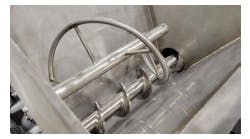Food and beverage processors are confronted with strict regulations to ensure that products are safe for the consumer. It is a constant challenge to keep up-to-date with the frequently changing mandates and to maintain compliance with regulatory agencies. Fortunately, today’s enterprise resource planning (ERP) solutions provide functionality to help companies stay in compliance and to mitigate the risks inherent in the food supply chain.
The Global Food Safety Initiative (GFSI) Standards triggered an increased emphasis on document and records management. Document management is now standard to multiple, global benchmarked standards: BRC Global Standard for Food Safety, FSSC 22000, International Feature Standards (IFS) and the Safe Quality Food (SQF) certification. Additional rules are found within the Food Safety Modernization Act (FSMA) — and all require various record keeping protocols.
The need for documented programs to support food and beverage companies continues to evolve to meet the demands of the various regulatory statutes, industry certifications and global requirements. Every company has unique sets of business systems and processes. The regulations require the capture and recall ability of a comprehensive set of information that covers traceability, control points and corrective actions designed specifically for the company’s systems and processes.
With the myriad demands on the system, how can a company ensure its data and records are accurate, current and accessible? It can begin by asking some fundamental questions:
- Which system will best support company needs?
- Which solutions should be implemented to alleviate risks?
- How can the necessary information requirements be met?
Regulatory compliance is often viewed and managed independently of a company’s ERP and manufacturing execution system (MES). This results in standalone regulatory/trade management systems that create risk as the business changes and inaccuracies are created with the parallel quality/compliance systems.
As information requirements become more comprehensive and required food recall times decrease, standalone compliance is no longer feasible. As a result, food manufacturers and processors are at risk of being out of compliance.
A holistic approach to ERP in F&B
ERP technology solutions are often overlooked when considering a comprehensive food safety and compliance strategy. Modern ERP solutions have evolved to address controls, records of items and specifications throughout the processing, sales and distribution stages. Existing functionality can eliminate much of the processing required by regulatory systems.
The opportunity to automate processes to meet food safety requirements is especially true for the implementation of new systems. It can help avoid the need for specific regulatory and trade systems while creating efficiencies regarding data entry and creating standardized data sets.
Realizing the opportunity
Processors have an opportunity to better align food safety activities with operational activities by integrating compliance information into the ERP system. The one common information source enables visibility into time-sensitive transactions. Each point at which a material changes can be captured as required by food safety compliance traceability requirements.
Data aligned with processes provides the capability to better support document requirements, including procedures and work processes. The core processes supported by ERP provide the process-level details, in conjunction with the material status-level required for food safety.
The key is maintaining an item of any type to a specification level based on process change or resulting conditions, such as the level of food safety for the item. The use of configuration to meet food safety requirements can solve the food safety dilemma of multiple systems and databases.
Tighter controls key to compliance
Manufacturing operations that plan and deploy physical product through the work order system can provide the key manufacturing process controls and records needed to assure the release of pure and unadulterated food.
When necessary, this functionality can deliver the information and records documenting the cause of adulteration, the proper segregation of material and a record certifying proper disposal of contaminated goods. In both of these ERP functional areas, the process and the approval condition of the various ingredients and products can be managed, monitored and controlled with all of the necessary tracking information.
Within storage and distribution, the required storage and handling criteria — including refrigeration — can be managed and tracked to ensure food condition is properly maintained through these activities.
The functionality supports the management and tracking necessary for the release of product and any conditions, with records for not releasing certain food product and meeting specifications for safe distribution.
Master file information for items, suppliers and manufacturing provides for complete recordkeeping and user controls. It supports only the release of safe food, while managing the disposal of contaminated product.
This status-level tracking is a key requirement to meet traceability and recall requirements. It is important to note that the time-based capability within ERP provides for the level of information, quantity and status of food product for recall compliance purposes.
Recipe management — a critical ingredient
The primary area of focus for food and beverage ERP is recipe management. All manufacturers are defined by the products they produce, but food and beverage companies face a more stringent expectation. Each recipe ingredient not only impacts the taste of the product, but also the nutritional value — a metric monitored strictly by numerous governmental regulatory agencies.
Food and beverage ERP solutions offer the following feature functions to aid in recipe management:
- Version control of items such as batch sheets and recipes/formulas that allows the processor to strictly manage which version is to be used in production.
- Formulation helps manage which ingredients are being used to create the product, meeting any requirement to calculate nutritional values that result from the formulation.
- Alternate and reverse bill of materials assist the manufacturer in quickly and efficiently identifying other raw materials that can be substituted if an out-of-stock is encountered.
- Alternate routings provide a means to predefine multiple ways of manufacturing an item. These alternative ways could be driven by factors such as batch size or overcapacity of a work center.
- Unit of measure conversions (e.g., pounds to kilograms) assist with accurately managing different units of measure for items. Examples of this include selling in a specific unit of measure (e.g., in pounds) versus purchasing (e.g., in kilograms) versus warehousing (in cases).
Safe food for the consumer is the ultimate goal
Ultimately, FSMA and industry certifications require complete records for all food products shipped to consumers. This is difficult to accomplish with existing information systems used within the food and beverage supply chain. Even companies with robust systems commonly lose track of the traceability information necessary for effective resources due to the limitations of their systems or that of their various suppliers and transporters.
The best option
The use of disparate systems that are not integrated and do not support real-time information only leads to more confusion and uncertainty, as has happened with some of the most recent food recalls.
Compliance, supply chain, trade and quality systems are common. But they often result in the implementation and maintenance of a variety of systems that do not provide common data access. They have the potential to provide a greater level of integration.
Without exception, the food safety status, release of product and control of non-conforming products and materials must demonstrate all product meets food safety requirements and that questionable products are properly controlled.
Use of complete systems like ERP offer not only the full status level for all materials, products and activities, but also the time-based and quantitative data of real-time information controls.
A best option for the food and beverage industry is to seek the use of ERP functionality that is properly configured for safe food processing, the release of safe food and the accurate, quantitative traceability of non-conforming product.
Richard Sides, COO of Ultra Consultants, has more than 20 years of technology-related operational experience assisting manufacturing and distribution organizations by improving their business processes and supporting information systems. His experience includes operational responsibilities, management consulting, ERP system implementation and serving in a variety of senior executive management roles. Sides’ background includes significant experience in process and discrete manufacturing as well as logistics, distribution and supply chain management. He has a bachelor’s degree in computer engineering from Lehigh University and an Masters in Business Administration from DePaul University.



